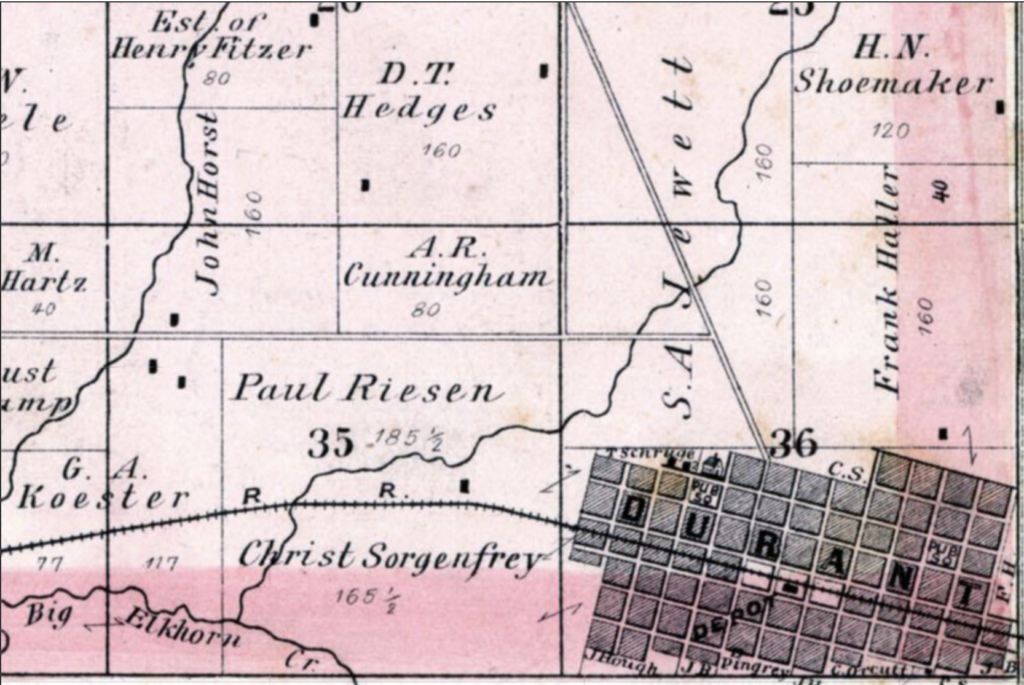By Walter W. Woodward
(c) Connecticut Explored Inc. Winter 2021-2022
Subscribe/Buy the Issue!
As Connecticans in the 1800s joined the throngs of pioneers seeking a better life in the American West, they eagerly sought first-hand accounts of potential settlement sites. Such reports often came as letters from friends or relatives. Sometimes they appeared as open letters in Connecticut newspapers. Two such accounts, written by different authors for The Hartford Courant three years apart in the late 1850s—and both about the new Iowa frontier “city” of Durant—underscore how varied these accounts could be and how opportunity, like beauty, is in the eye of the beholder.
Located on prairie 20 miles west of the Mississippi River town of Davenport, the site that became Durant had, according to the city’s website, been identified in 1854 as both a future city and a depot for Iowa’s first railroad line. Streets and lots were laid out, a hotel and depot built, and the new settlement named in 1855 for Thomas C. Durant, the president of the Mississippi and Missouri Railroad.
Shortly thereafter, John S. Whittlesey, a Yale College-educated migrant from Bethel, Connecticut, arrived as Durant’s first Congregational minister. Once settled in, he wrote an open letter to The Hartford Courant, published May 1856, titled “First Impressions of Iowa.”
Whittlesey was delighted with his new community, where he could “behold at one view a hundred splendid farms of 160 acres each.” For land-strapped Connecticans who had struggled for generations to raise families on small plots of nearly exhausted soil, Whittlesey sang a siren song. “I see on every side the plow turning up the black, rich, soil which for centuries has lain undisturbed,” he wrote. “The beauty and grandeur of the vast rolling prairies … are beyond all description. … Every where there is deep black soil, every foot of it as rich as a Wethersfield onion garden, and richer, if the size of the onions is any test.”
Whittlesey’s assessment of Durant was not shared, however, by “J.C.,” whose story, “The West As Seen By a Yankee,” was published by The Courant in June 1859. “The village plat, laid out some five years ago makes a very pretty appearance on paper,” J.C. wrote. “… But alas! … the Park is without trees, Union Square grass-grown, and the houses and wheel tracks yclept avenues appear to be dropped at random.” Though the surrounding prairies were “beautifully rolling, … not one tenth of the land … is yet enclosed, but remains in the hands of speculators.”
Durant’s farmers were endangered by two straight years of crop failures, and overwintered cattle were dying of starvation. The prairies were almost devoid of trees. J.C. noted that Iowans were dependent on coal, not wood, for fuel, “which gives forth dense fumes while burning.” He concluded, “Should any restless Yankee feel inclined to leave Connecticut for the West, I would tell him that of all the families that I know here, there is not one from Connecticut that does not honestly wish itself back again … . At present, all here work hard, live low, and hope for better times in the future.”
J.C. did not stay in Durant long. “I am,” he closed his letter, “soon to leave for Nebraska.” Rev. Whittlesey’s time in Durant was cut short by the Civil War. He was appointed chaplain of the 11th Regiment Iowa Volunteer Infantry in October 1861 and died the following May of diptheria.
Walter Woodward is the Connecticut state historian. Listen to his podcasts at Gratingthenutmeg.libsyn.com and visit TodayinCTHistory.com.
GO TO NEXT STORY
GO BACK TO WINTER 2021-2022 CONTENTS

